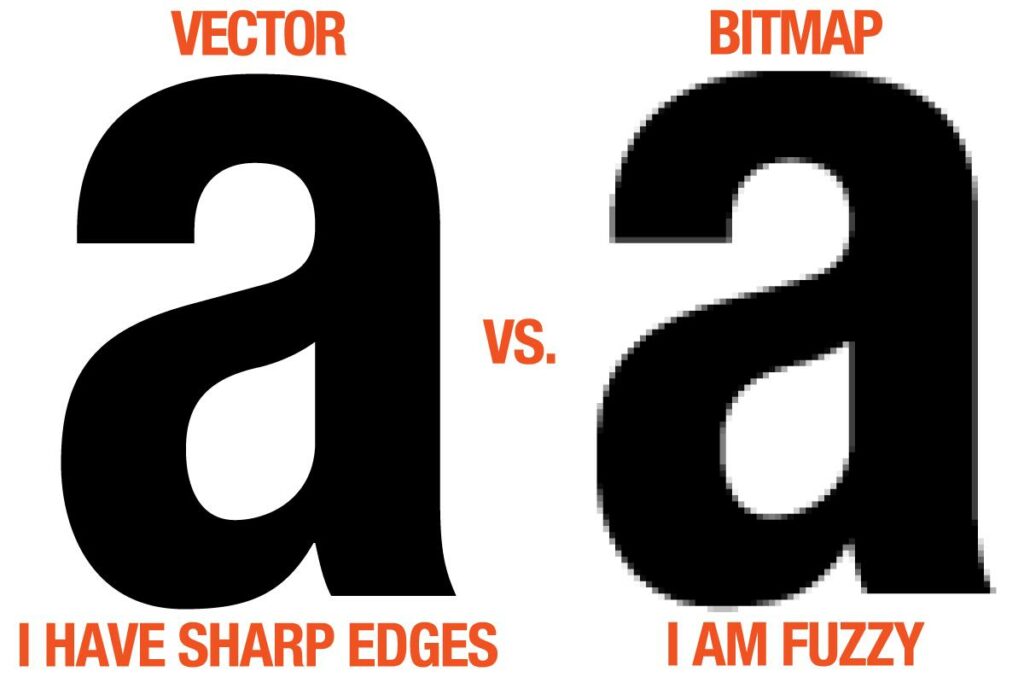Understanding the difference between vector files and bitmap files is crucial. Both file formats have their strengths and weaknesses, and choosing the right one for your specific needs can significantly impact the quality and versatility of your work. In this blog post, we will explore the characteristics, applications, and benefits of vector files and bitmap files to help you make informed decisions when working with digital imagery.
Vector Files:
Vector files are created using mathematical equations that define geometric shapes, lines, and curves. Instead of storing pixel data, they store information about the objects and attributes within an image. Here are some key aspects of vector files:
Scalability:
Vector graphics are resolution-independent, meaning they can be scaled up or down without any loss in quality. The mathematical formulas used in vector files allow them to be infinitely resized, making them ideal for designs that require flexibility and adaptability.
Precision and Editability:
Since vector files are composed of individual objects, each element can be easily modified, moved, or resized without affecting other parts of the image. This makes vector files highly editable and perfect for projects that involve extensive revisions or customization.
File Formats:
Common vector file formats include SVG (Scalable Vector Graphics), AI (Adobe Illustrator), EPS (Encapsulated PostScript), and PDF (Portable Document Format). These formats are widely supported by various design software and can be used across different platforms.
Applications:
Vector files are particularly suitable for creating logos, icons, typography, technical illustrations, and print media, where clean lines, scalability, and editing capabilities are essential. They are also used extensively in web design, infographics, and mobile application development.
Bitmap Files:
Bitmap files, also known as raster files, consist of a grid of individual pixels, where each pixel carries specific color and brightness information. Unlike vector files, bitmap files store data for each pixel, resulting in a fixed resolution and size. Let’s explore some key characteristics of bitmap files:
Resolution and Detail:
Bitmap images have a fixed resolution, which means they are made up of a specific number of pixels. When a bitmap image is resized, the number of pixels remains the same, resulting in a loss or gain of detail, depending on the scaling direction. Enlarging bitmap images too much can lead to pixelation and loss of clarity.
Photorealism:
Bitmap files are excellent for capturing complex and detailed images, such as photographs or natural scenes, as they can reproduce subtle variations in color, shading, and texture.
File Formats:
Common bitmap file formats include JPEG (Joint Photographic Experts Group), PNG (Portable Network Graphics), GIF (Graphics Interchange Format), and TIFF (Tagged Image File Format). Each format has its own compression methods and suitability for specific use cases.
Applications:
Bitmap files find their primary applications in photography, digital art, and any graphics requiring photorealistic representation. They are widely used on the web, in digital publications, and for multimedia presentations. However, they may not be the best choice for designs that require scalability or extensive editing.

Choosing the Right Format:
When deciding between vector files and bitmap files, consider the specific requirements of your project. If you need scalability, flexibility, and easy editing, vector files are the way to go. On the other hand, if you’re dealing with photographs or complex visuals, or if your project doesn’t require extensive resizing or editing, bitmap files are a suitable choice.
Conclusion:
Understanding the difference between vector files and bitmap files is crucial for digital designers and graphics enthusiasts. While vector files offer scalability, precision, and flexibility, bitmap files excel at capturing photorealistic images. By considering the specific requirements of your project, you can choose the appropriate.
When choosing our screen-printing services, we require that our customers provide a vector art file for their chosen design. Screen printing will give your product a perceived higher value than labeling alone. Add your logo, and your product line design, or have one of our graphic designers help bring your vision to life. Our team will work with you closely to ensure your desired outcome is achieved. Take a look at our special techniques to help your brand and product to stand out. Contact us today to get started!
